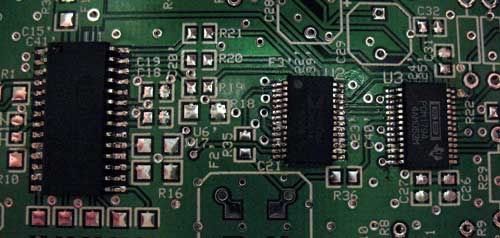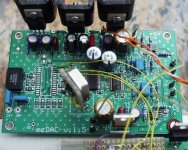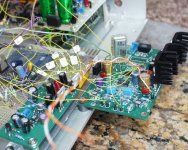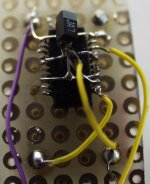6h5c said:That would be quite ironic, if you couldn't get one to work LOL 😀.
I brought in the board to my lab so I could take a look under the microscope. Using some forceps I could "feel" that some of the pins are loose on the PCM1794 chip. Kind of like checking for cavities. I'll need to go over those pins again. I just hope I haven't applied to much heat to the chip. Ray, when you solder, how long do you leave the tip on each pin? 1-2 seconds? A little longer? Same question for solder wick, if you use it.
No, I think it's even less, more like between half a second and a second. It depends a bit on the circumstances, a connection on a groundplane takes longer of course. It's touch-and-go, almost simultaneously with the tip and the solder wire.
Solder wick takes more time, because the wick needs to heat up, maybe upto three seconds. But the risk of damage is smaller here, because the wick takes up a lot of heat.
In general, most of the heat applied to an IC-pin is taken away by the board and the package. The internal connection from a pin to the die is very thin, so there's very little direct heat transfer. You have to 'bake' it quite long to do any damage. These components survive wave and reflow soldering you know, sometimes multiple passes!
Ray
Solder wick takes more time, because the wick needs to heat up, maybe upto three seconds. But the risk of damage is smaller here, because the wick takes up a lot of heat.
In general, most of the heat applied to an IC-pin is taken away by the board and the package. The internal connection from a pin to the die is very thin, so there's very little direct heat transfer. You have to 'bake' it quite long to do any damage. These components survive wave and reflow soldering you know, sometimes multiple passes!
Ray
Have any of you guys noticed my ezdiyaudio.informe.com forum seems to be down? I hope it's not gone forever. Maybe I'll have to find a new host.
Yes, I tried to have a browse on there but got the page unavailable , fingers crossed they sort it
Leo
Leo
Mine is singing already. Sound is surprisingly nice. It is a SRC4192/PCM1798 at present with AD8610 at output. As my Digikey order has not yet arrived and i couldn't get a 24.576 oscillator locally, clocking is done from a PLL1705. The source is a PCM2707(USB) connected via I2S to the SRC (no spdif receiver yet).
My main objective behind this build was to observe differences caused by ASRC (will take it out in a couple of days) and also to compare AD1896 to the SRC4192. Will probably try the fast filtering as well.
Building was very easy and pleasant. Great boards!
Many thanks to ezkcdude.
My main objective behind this build was to observe differences caused by ASRC (will take it out in a couple of days) and also to compare AD1896 to the SRC4192. Will probably try the fast filtering as well.
Building was very easy and pleasant. Great boards!
Many thanks to ezkcdude.
analog_sa said:Mine is singing already. Sound is surprisingly nice. It is a SRC4192/PCM1798 at present with AD8610 at output. As my Digikey order has not yet arrived and i couldn't get a 24.576 oscillator locally, clocking is done from a PLL1705. The source is a PCM2707(USB) connected via I2S to the SRC (no spdif receiver yet).
My main objective behind this build was to observe differences caused by ASRC (will take it out in a couple of days) and also to compare AD1896 to the SRC4192. Will probably try the fast filtering as well.
Building was very easy and pleasant. Great boards!
Many thanks to ezkcdude.
Good to hear it!
analog_sa said:The Digikey parcel arrived and i got to replace the ridiculous looking PLL1705 contraption with a cute SM crystek oscillator. Sadly, the sound took a dive. Maybe these PLLs are indeed low jitter.
Hm, 'a dive' is a bit much for a different oscillator. What partnumber did you use? I'm curious if the jitter specs are in the datasheet. And then I can make sure to avoid this part in the future 🙂
The PLL1705 is supposed to have 50ps clock jitter, according to the datasheet. A decent fixed oscillator should be able to do much better nowadays though.
Ray
Thats interesting because the Crysteks are reported to be good.
I've only used the Crystek C3291, 50MHz for Asynchronous reclocking
I've only used the Crystek C3291, 50MHz for Asynchronous reclocking
Gentlemen
After reading your posts i had an episode of self doubt and guilt for posting too soon. Another switch back and forth between the PLL1705 and a Crystek ASV-24.576MHz-E-J-T (Digikey 535-9318-1-ND) only confirmed my initial impressions.
It's easy and common to exaggerate sonic differences but this one is almost of the type "my wife came running from the kitchen to see what i've done to the stereo" 🙂
First of all with the PLL the subjective loudness is higher. There is more bass foundation, more stability to the images. Better dynamics.
The board is not particularly well made as it was only meant as a temporary solution.
After reading your posts i had an episode of self doubt and guilt for posting too soon. Another switch back and forth between the PLL1705 and a Crystek ASV-24.576MHz-E-J-T (Digikey 535-9318-1-ND) only confirmed my initial impressions.
It's easy and common to exaggerate sonic differences but this one is almost of the type "my wife came running from the kitchen to see what i've done to the stereo" 🙂
First of all with the PLL the subjective loudness is higher. There is more bass foundation, more stability to the images. Better dynamics.
The board is not particularly well made as it was only meant as a temporary solution.
Attachments
- Status
- Not open for further replies.
- Home
- Source & Line
- Digital Source
- EZDAC is singing now!!!





